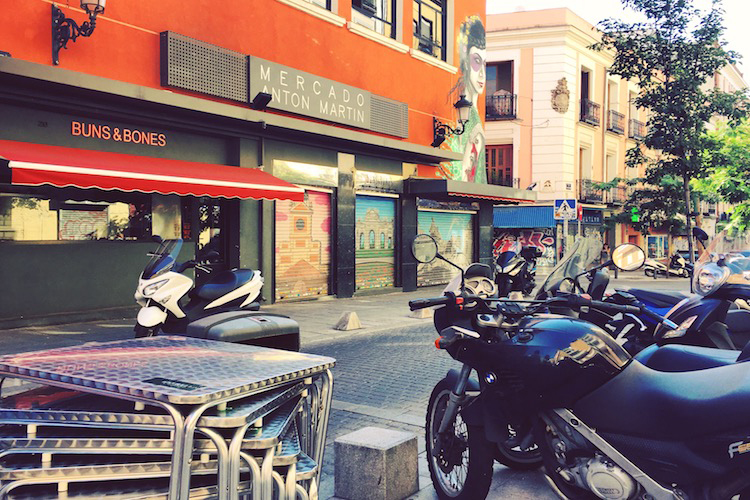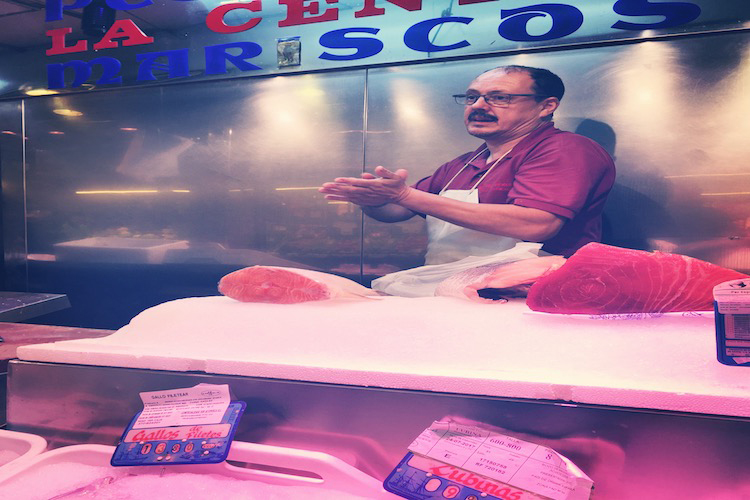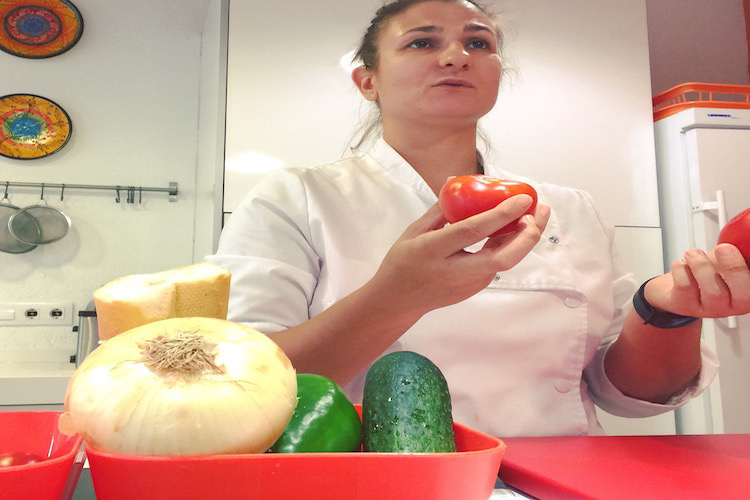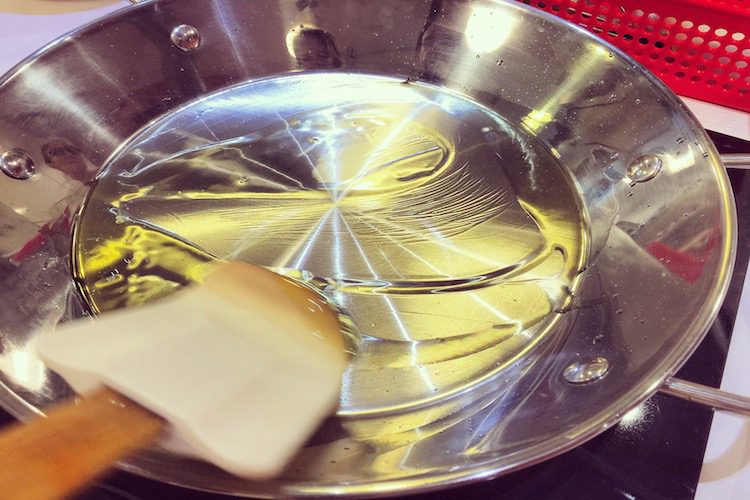Olive oil sizzled on a pan as garlic was sprinkled on top of browning chicken. A few inches away, fresh tomato, cucumber, pepper, onion, and bread were blended, creating a smooth, orange-red soup. Just across the counter, a chilled pitcher of a dark red fruit-infused beverage was then poured over ice, topped with a slice each of apple and peach – a sweet taste of summer!
Delicious scents wafted through the air as a Madrileño chef guided us through the preparation of a trio of Spain’s most traditional mealtime delights.
Paella….gazpacho…sangría!
These you’ll find both on restaurant menus throughout the country and in the homes of countless Spaniards. But this delicious experience mustn’t be limited to your time on vacation.

Mercado Antón Martín, a go-to for local Madrileńos, has served customers since 1941 | Grace Olson
Located right in the heart of Madrid, the Cooking Point cooking school provides an opportunity for tourists to learn and experience the preparation process from top-to-bottom.
“If you go to a paella restaurant, you will get to eat paella once. If you come over here, you will get to eat paella your whole life because you will learn this forever. And I think it’s a way of getting closer to the culture you’re visiting,” explained local chef Laura Lospitao, our guide and mentor.
There’s no mistaking that Laura’s heart is close to the value of this traditional cuisine. It’s the food that she was raised on, and her vast knowledge of it is a gift that keeps on giving to countless visitors who now enter this kitchen of learning.
While a day’s course with a Cooking Point chef will beg 70 Euros (82 US dollars) per person, the value packed into this four-hour adventure is truly intangible.
I couldn’t help but give it a try, and my day as a chef-in-training began with a 10am arrival at the cooking school. A friend joined me, and we met Laura in the kitchen. We then walked to a nearby market called “Mercado Antón Martín,” a staple for locals serious about buying the highest quality meat and fish.

A longtime employee of the Anton Martín market chats with the cooking class instructor as he gathers the necessary raw fish | Grace Olson
We traversed many sections of the market, observing vivid, fresh vegetables; an entire corner dedicated solely to a plethora of juicy olives; and chicken, ham, and seafood counters, recently stocked full of the freshest meat and seafood around.
Laura seemed to know everything about all of the items we bought and countless more, explaining even how to best select meats we weren’t buying that particular day.
“What I try to do is explain a lot of background of the recipes. I think it’s important that you know what you’re eating and why you’re eating it. I think it’s important to get to know first the name of where the recipe comes from, which language it was originated with…which culture brought it here.”
Over at the veggie counter, in the same informative fashion, she told us that tomatoes used for gazpacho must be very ripe and juicy. So, she sticks with either the vine or Roma varieties. She said that when she walks up to get the tomatoes, the employees already know what she is coming to buy and accordingly prepare whatever is best at the time.
Her interactions with market vendors that day was evidence of the close relationships they’ve developed through care for their daily work.
Down the aisle, on top of another counter, sat a batch of eggs and a straw chicken decoration. Behind it, fresh “pollo” was being cut and handed to other customers. As we waited our turn, Laura pointed to the poultry selection.
“That right there, the yellow chicken, that’s the one we want for paella because it’s tastier and more juicy. With this, we don’t even need oil because the fat from the skin will melt. The chicken needs to have skin to give the paella more flavor.”
After then delighting in a selection of olives available for sample, we took inventory of our bags and headed back to get our kitchen party started. Laura pulled out some bowls, knives, and cutting boards, and began leading us through the process.
When asked if there are common misconceptions people arrive with, she did not even have to think before responding.
“The most common question that I get is when we add chorizo (Spanish pork sausage), which we don’t. And the second one is that they think the rice goes into the broth and then you pour everything into the pan.”
Well, I’ll say now from experience that dumping everything into a pan is far from what actually happens!

Cooking Point instructor Laura Lospitao describes the importance of juicy tomatoes in gazpacho and paella as she guides a morning cooking class | Grace Olson
After much dicing, chopping, browning, simmering, stirring, grating, sprinkling, and seasoning of vegetables and spices, we were finally to the point of adding the rice – step number nine of nineteen.
“It’s all in the flavor and the texture of the rice,” Laura said as I poured dry Bomba rice kernels into the simmering mixture. “It should never be mushy. You should have really loose rice and flavors should be pretty fresh.”
In fact, the “Golden Rule” as Laura called it, is that you must leave the rice alone once the broth is poured in – no stirring! And while particular heat increments are directed, it’s important that the chef learn to watch and observe how to adjust the termperature as needed.
The eats-in-prep smelled so enticing throughout the process, it was tough not to indulge before mealtime. But, a refreshing glass of sangría enjoyed along the way helped keep the taste buds satisfied.
Eventually, we’d blended and chilled the gazpacho and the paella was complete. Laura had outfitted a table with tablecloths, napkins and silverware.
Concluding the experience, Laura joined me and my friend as we enjoyed the meal we’d had such a blast learning to prepare. The adventure was full of laughs, learning, and quality time spent both with an old friend and a new one made in Laura.
A traveler like me, thirsty for a deep-dive into a different culture, couldn’t ask for more.
Class time: 4 hours total; 3 for market shopping and preparing meal; 1 for enjoying it
Cost: €70 ($82) per person
Class Schedule: Paella-making class: Monday – Saturday, 10am – 2pm
Tapas-making class: Monday – Saturday, 5:30pm – 9:30pm
Web link: https://cookingpoint.es
Address: Calle de Moratín, 11, 28014 Madrid, Spain
Metro stop: Antón Martín, then a five minute walk
Phone: +34 910 11 51 54
Travel Journalism, Photography & Video Internship Seminar in Madrid, Spain

